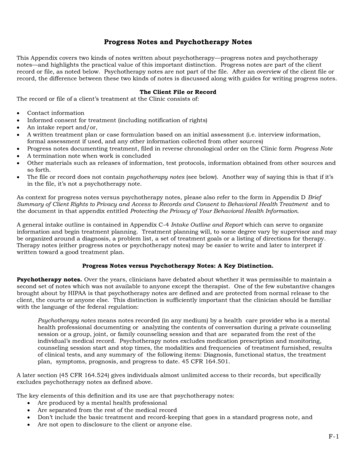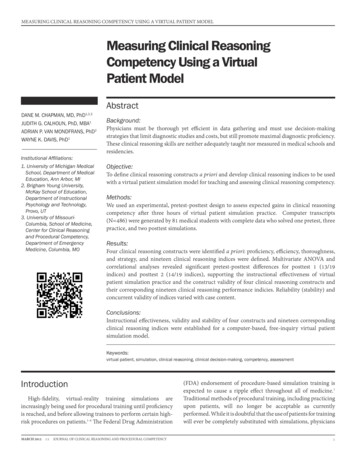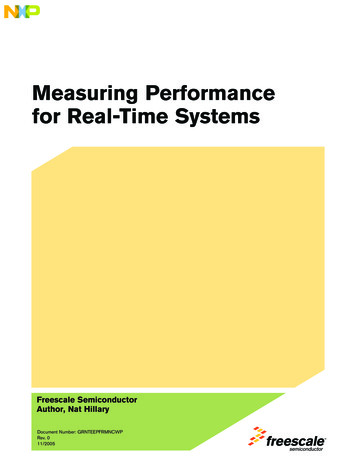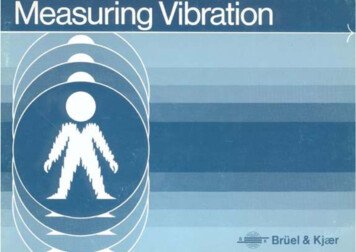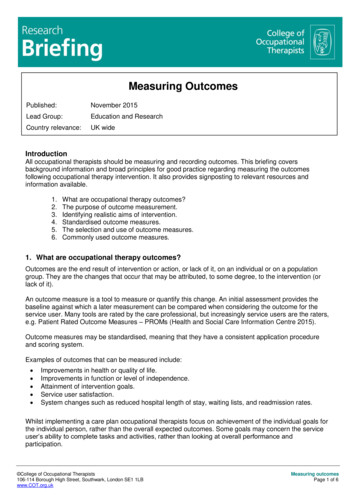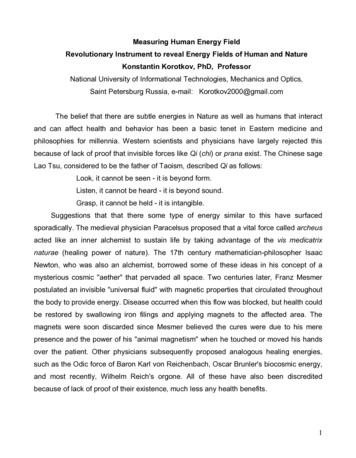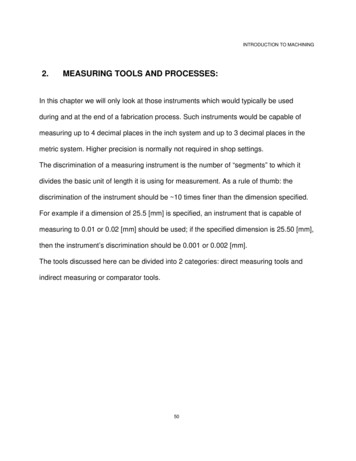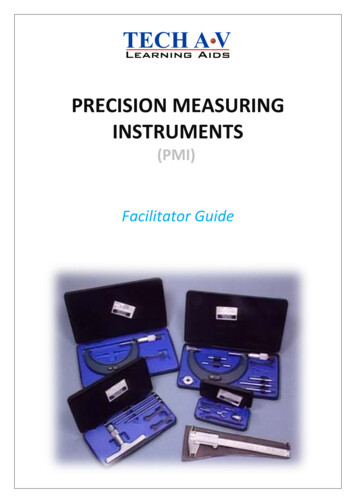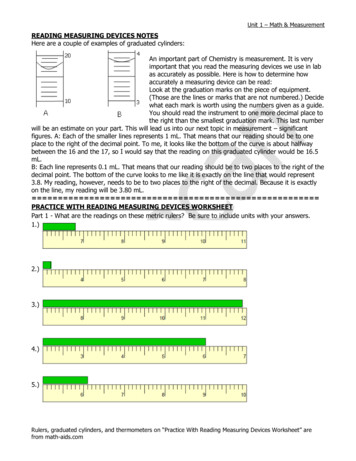
Transcription
Unit 1 – Math & MeasurementREADING MEASURING DEVICES NOTESHere are a couple of examples of graduated cylinders:An important part of Chemistry is measurement. It is veryimportant that you read the measuring devices we use in labas accurately as possible. Here is how to determine howaccurately a measuring device can be read:Look at the graduation marks on the piece of equipment.(Those are the lines or marks that are not numbered.) Decidewhat each mark is worth using the numbers given as a guide.You should read the instrument to one more decimal place tothe right than the smallest graduation mark. This last numberwill be an estimate on your part. This will lead us into our next topic in measurement – significantfigures. A: Each of the smaller lines represents 1 mL. That means that our reading should be to oneplace to the right of the decimal point. To me, it looks like the bottom of the curve is about halfwaybetween the 16 and the 17, so I would say that the reading on this graduated cylinder would be 16.5mL.B: Each line represents 0.1 mL. That means that our reading should be to two places to the right of thedecimal point. The bottom of the curve looks to me like it is exactly on the line that would represent3.8. My reading, however, needs to be to two places to the right of the decimal. Because it is exactlyon the line, my reading will be 3.80 mL. PRACTICE WITH READING MEASURING DEVICES WORKSHEETPart 1 - What are the readings on these metric rulers? Be sure to include units with your answers.1.)2.)3.)4.)5.)Rulers, graduated cylinders, and thermometers on “Practice With Reading Measuring Devices Worksheet” arefrom math-aids.com
Unit 1 – Math & MeasurementPart 2 – What are the readings on these graduated cylinders? Be sure to include units with youranswers.6.)7.)8.)9.)10.)Notes and Worksheets11.)12.)13.)2
Unit 1 – Math & MeasurementPart 3 – What are the readings on these thermometers? Be sure to include units with your answers.14.)15.)16.)17.)Part 4 – What are the readings on these triple beam balances? Be sure to include units with youranswers.18.)19.)Notes and Worksheets3
Unit 1 – Math & MeasurementACCURACY & PRECISION NOTESUp until now, you probably thought of accuracy and precision as the same thing. I know I did until Igot to Chemistry class in high school. There is actually a difference between the two.ACCURACY: how close a measurement is to the actual (accepted) valuePRECISION: how close measurements are to each otherLet’s use a dart board as an example.bad accuracy,bad accuracy,good accuracy,bad precisiongood precisiongood precisionEXAMPLE: Describe the accuracy and precision of each group’s measurements, given the following dataand that the actual mass of the object is 7.00 grams.Trial123Group A7.62 g8.94 g6.21 gGroup B6.98 g7.00 g6.99 gGroup C7.72 g7.75 g7.71 g SIGNIFICANT FIGURES (SFs or Sig Figs) NOTESHow to Determine the Number of Significant Figures (SF) a Measurement Has.** Any non-zero number (1, 2, 3, 4, 5, 6, 7, 8, 9) is ALWAYS significant. **1. "Sandwiched" zeroes (zeroes in between two non-zero numbers) are ALWAYS significant.EXAMPLE: 103 has 3 SFs 5007 has 4 SFs2. “Leading” zeroes (zeroes to the left of a non-zero number) are NEVER significant.EXAMPLE: 0.000375 has 3 SFs3. “Trailing” zeroes (zeroes to the right of non-zero numbers) are significant ONLY if a decimal point iswritten in the number. (Note: The decimal point can be located anywhere in the measurement.)EXAMPLES: 50 has 1 SF50. has 2 SFs50.0 has 3 SFsPRACTICE EXAMPLES:a. 25 cmb. 30015 cmc. 0.00123 ind. 400 ge. 400. mf. 0.94600 mLg. 2.70 x 1025 atomsh. 0.070500 kmRules For Deciding How Many SFs an Answer Should Have.** When multiplying or dividing.Your answer must have as many SFs as the number in the problem with the fewest (lowest) number ofSFs.Notes and Worksheets4
Unit 1 – Math & MeasurementEXAMPLE:EXAMPLE:9.34 cm x 4.5 cm calculator says 42.03(3 SF)(2 SF)Must round to 2 SFs -- so, answer is 42 cm2.2.494 m x 3.02 m x 5.125 m calculator says 38.60085(4 SF)(3 SF)(4 SF)Must round to 3 SF -- 38.6 m3** When adding or subtracting. Your answer must have as many places to the right of the decimalpoint as the number in the problem with the fewest number of places to the right of the decimal.EXAMPLE: 2.194 g 25.84 g 5.7210 g calculator says 33.755(3 places)(2 places)(4 places)Must round to 2 places -- 33.76 g SIGNIFICANT FIGURES WORKSHEETPART 1 - Determine the number of significant figures in the following numbers.1.) 0.022.) 0.0203.) 5014.) 501.05.) 5,0006.) 5,000.7.) 6,051.008.) 0.00059.) 0.102010.) 10,001PART 2 – Rewrite/round each of the following numbers so that it has 3 significant figures.1.) 0.030062.) 0.000411933.) 10,800,000.4.) 0.901495.) 2.195 x 1026.) 2.998 x 10217.) 0.0079978.) 80489.) 90,18510.) 699.5ROUNDING & SIGNIFICANT FIGURES WORKSHEETPerform the following operations expressing the answer with the correct number of significant figures.1.) 1.35 m x 2.467 m 2.) 1,035 m2 42 m3.) 0.021 cm x 3.2 cm x 100.1 cm 4.) 150 km3 4 km25.) 1.252 mm x 0.115 mm x 0.012 mm 6.) 1.278 x 103 m2 1.4267 x 102 m7.) 55.46 g - 28.9 g 8.) 12.01 mL 35.2 mL 6 mL 9.) 0.15 cm 1.15 cm 2.051 cm 10.) 505 kg - 450.25 kg Notes and Worksheets5
Unit 1 – Math & MeasurementDENSITY NOTESThe formula for density is: D massvolumeRemember. volume of a rectangular solid is (length x width x height)EXAMPLE: A cube-shaped sample of gold has a mass of 65.78 grams. If each side of the cubemeasures 1.50 cm, what is the density of gold? DENSITY PROBLEMS WORKSHEET (round your answers to the correct # of SFs)1.) Determine the density of a rectangular piece of concrete that measures 3.7 cm by 2.1 cm by 5.8 cmand has a mass of 43.8 grams.2.) Determine the density of a piece of granite that measures 5.02 cm by 1.35 cm by 2.78 cm and hasa mass of 30.64 grams.3.) Determine the density of a brick in which 49.92 grams occupies 4.01 cm3.4.) Gold has a density of 19.32 g/cm3. Find the mass of 6.39 cm3 of gold.5.) Determine the volume of 6.37 grams of magnesium if its density is 1.29 g/cm3.6.) Determine the volume of 15.64 grams of iron if its density is 2.27 g/cm3.7.) A graduated cylinder contains 30.0 mL of water. An object is placed in the cylinder and the waterlevel moves to 46.7 mL. Find the density if the mass of the object is 121.3 grams.8.) A ball has a mass of 6.03 kilograms and a volume of 10.57 cm3. Find the density of the ball.9.) A piece of wood has a mass of 5.75 grams and a volume of 0.95 cm3. Find its density. PERCENT ERROR NOTESFormula for % error: accepted value - experimental value x 100accepted valueEXAMPLE: A student measures a sample of matter to be 9.67 grams. The teacher tells the class thatthe actual mass of the sample is 9.82 grams. What is the student’s percent error?Notes and Worksheets6
Unit 1 – Math & MeasurementUNIT CONVERSIONS NOTESBIGGERprefixabbrev.# oftimesbaseunit ----GigaG1 x 109-----MegaM1 x 106-----kilok1 x 103-----hecth1 x 102-----decada1 x 101B -----A deciSdE 1 x 10-1-----centic1 x 10-2-----millim1 x 10-3----- microμ1 x 10-6smallernanon1 x 10-9EXAMPLES OF BASE UNITS ARE:How to set up a unit conversion:number and unit you are given appropriate # and unit you’re converting to appropriate # and unit you’re givenThese numbers and units are referred to as a CONVERSION FACTOR.The numbers and units in a conversion factor must be equal to each other.There will be different numbers and units, but the amounts must represent the same thing.An example of a conversion factor: 12 eggs 1 dozen (difft. #s and difft. units, but values are )To solve a unit conversion problem: Multiply the numbers across the top of the set up. Then, divide by the number on the bottom of the set up.To set up conversion factors for metric system unit conversions:1.) Decide on the units for the numerator and denominator of the conversion factor.Example: Problem asks to convert 4.5 grams (g) to milligrams (mg)Set up: 4.5 gmg The unit on the bottom right side of the set-upgshould be the same as the given unit– always!!!2.) To set up conversions between metric prefixes, look at the units in the conversion factor. The unitwith a prefix will have a “1” next to it.Example: grams are larger than milligrams, so “g” will have a “1” in front of it.Set up: 4.5 g1 mg g3.) The number in front of the other unit will correspond to the number associated with the prefix.Example: milli- corresponds to 1 x 10-3 (milli- lowercase m in “mg”)Set up: 4.5 g1 mg 1 x 10-3 g4.) Multiply 4.5 by 1. Then, divide by 1 x 10-3. Answer is 4500 or 4.5 x 103 mg.For volume conversions, remember that 1 cm3 1 mL and 1 dm3 1 L (These are also conversionfactors.) Notes and Worksheets7
Unit 1 – Math & MeasurementUNIT CONVERSIONS WORKSHEET1.) 360 g to μg11.) 18.05 m to Mm2.) 0.00238 cg to g12.) 3.80 dL to L3.) 13.52 cm3 to mL13.) 1.428 x 107 m to km4.) 0.014 g to cg14.) 30.2 μL to L5.) 2.85 x 104 L to dm315.) 4.06 x 1012 nm to m6.) 41.5 mL to L16.) 1.05 dm3 to cm37.) 281 cm3 to L17.) 35.85 Mm to m8.) 4.305 L to dL18.) 4.32 L to cm39.) 61.2 mL to dm319.) 6.643 x 10-5 km to m10.) 1.832 L to mL20.) 6.58 m to nm UNIT 1 REVIEW WORKSHEETPart 1 - Unit Conversions1.) 0.9785 kg to g2.) 2830 mm to m3.) 19.3 L to cL4.) 3.4 g to Mg5.) 6.75 x 105 cm3 to dm3Part 2 - Tell the number of significant figures in each of the following measurements.6.) 48 cm7.) 306.2 g8.) 0.329 m9.) 83.952 K10.) 3700 mm11.) 400. cm312.) 71.60 g13.) 82.000 gPart 3 - Perform each of the following calculations, expressing the answer to the correct number ofsignificant figures.14.) 3.482 cm 8.51 cm 16.324 cm 15.) 8.3 m x 4.0 m x 0.9823 m 16.) 4.93 mm2 18.71 mm17.) 106.5 mL - 32 mL Part 4 - Percent Error18.) Experimental value 1.24 g, Accepted value 1.30 g19.) Experimental value 22.2 L, Accepted value 22.4 L20.) A person attempting to lose weight on a diet weighed 175 lb on a bathroom scale at home. Anhour later at the doctor's office, on a more accurate scale, this person's weight is recorded as178 lb. Assuming that there was no real weight change in that hour, what is the percent errorbetween these readings?Part 5 – Density21.) What is the mass of a sample of material that has a volume of 55.1 cm3 and a density of6.72 g/cm3?22.) A sample of a substance that has a density of 0.824 g/mL has a mass of 0.451 g. Calculate thevolume of the sample.Notes and Worksheets8
Unit 1 – Math & MeasurementThickness of Aluminum FoilINTRODUCTIONThe density of a material is given by the formula D m/V (Density mass divided by Volume). From Geometry,it is known that the volume of a rectangular solid is length times width times height (V l .w.h). It can beassumed that the thickness of the aluminum foil is the height. The density of aluminum can be looked up in atable. Therefore, using substitution and then rearranging the equation, one can solve for the height.PROCEDURE1. Select four (4) rectangular pieces of aluminum foil. Each piece should be a different size.2. Determine the mass of each piece of foil (in grams). Record these measurements in the data table below.3. Carefully measure the length and the width of each piece of aluminum foil. (Make sure you use the metricside of the ruler!) Record these measurements in the data table also.4. The accepted thickness of aluminum foil is 0.00254 cm for heavy duty aluminum foil. The density ofaluminum is 2.702 g/cm3.DATA TABLETrialMass (g)Length (cm) Width (cm)Thickness (cm)Error (cm)Percent Error1234AverageCALCULATIONSYou must show sample calculations (in detail - for only one of your trials) for (A) thickness, (B) error, and (C)percent error.NOTE: error accepted value – experimental value ANALYSISUnder your sample calculations, write out one potential source of error* in the lab. * Errors in the measuringdevice or the reading of the measuring device are not acceptable. For example, "we read the ruler incorrectly."would NOT be an acceptable source of error. Your source of error should come from the lab procedure that youfollowed or assumptions that were made about the materials used.THIS LAB IS DUE ON:**CRITERIA IN ORDER TO RECEIVE CREDIT FOR THIS ASSIGNMENT:* All numbers are clear & legible.* All numbers are labeled with their correct units.* Calculations are shown in detail.* Calculations are shown in a neat and logical order.* No messy cross-outs or eraser marks.* Failure to follow these criteria will result in your having to re-submit your lab. It will be considered a late gradewhen you re-submit.Notes and Worksheets9
7.) A graduated cylinder contains 30.0 mL of water. An object is placed in the cylinder and the water level moves to 46.7 mL. Find the density if the mass of the object is 121.3 grams. 8.) A ball has a mass of 6.03 kilograms and a volume of 10.57 cm3. Find the density of the ball. 9.) A piece of wood has a mass of 5.75 grams and a volume of 0 .


